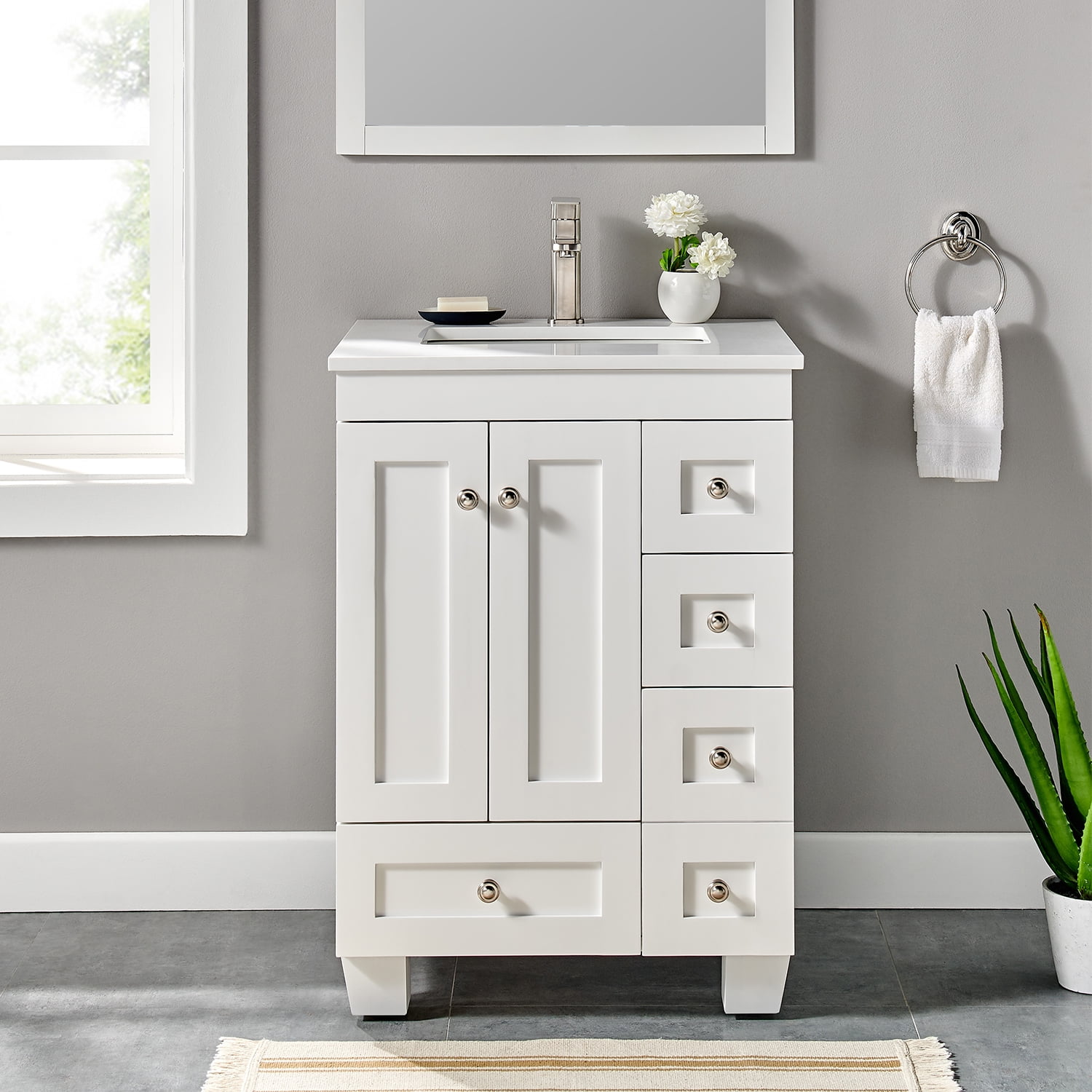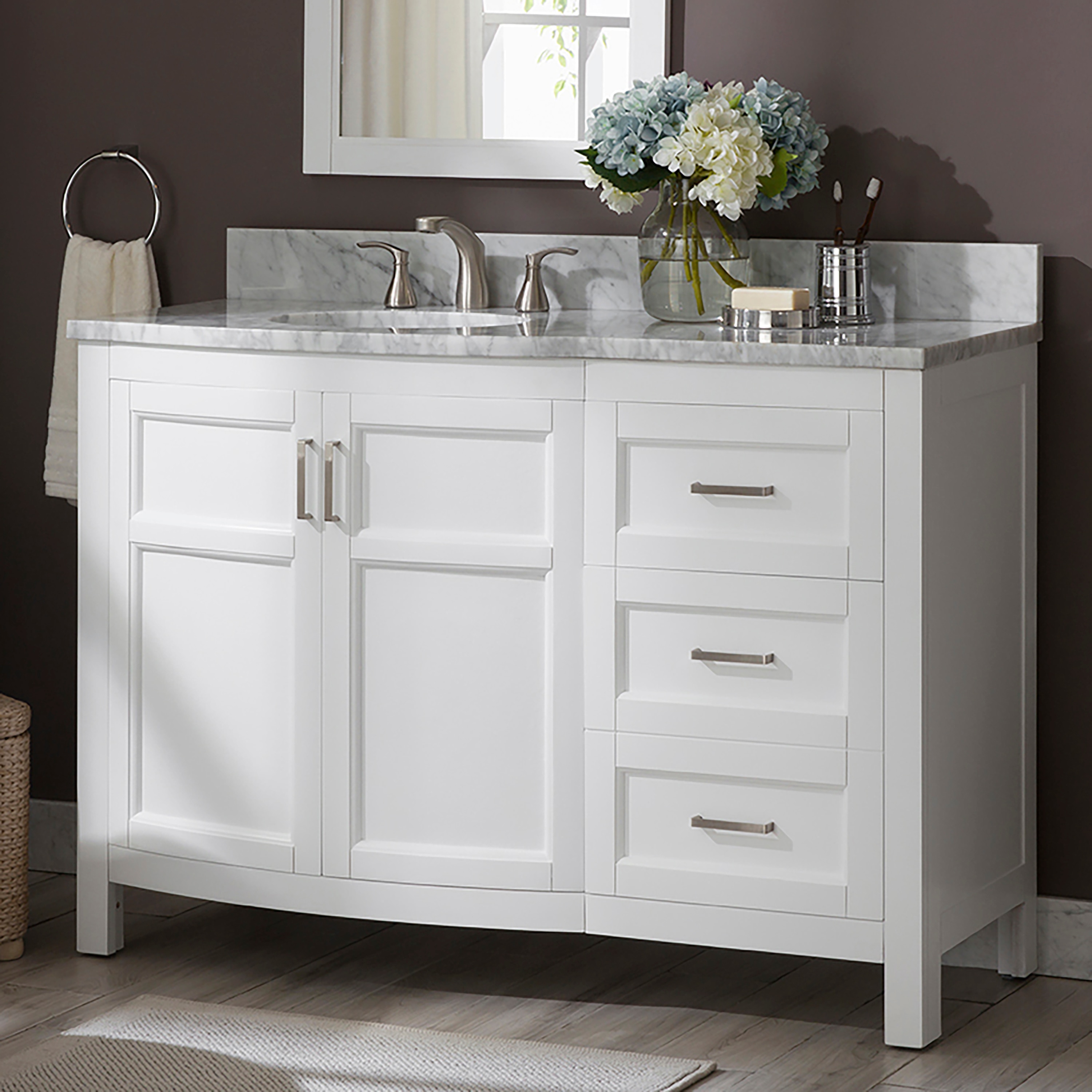Bathroom Vanity Styles and Designs: Bathroom Vanities Overstock Com

Overstock.com offers a wide selection of bathroom vanities in various styles and designs to suit every taste and need. Whether you’re looking for a modern, traditional, farmhouse, contemporary, or industrial vanity, you’ll find the perfect one to enhance your bathroom’s aesthetic and functionality.
Bathroom Vanity Styles
Bathroom vanities come in a variety of styles, each offering a unique look and feel.
- Modern vanities are characterized by clean lines, minimalist designs, and sleek finishes. They often feature geometric shapes, bold colors, and high-quality materials like stainless steel, glass, and acrylic.
- Traditional vanities exude timeless elegance and sophistication. They typically feature intricate details, ornate carvings, and classic finishes like brushed nickel or oil-rubbed bronze.
- Farmhouse vanities are inspired by rustic charm and country living. They often feature distressed wood, weathered finishes, and simple, functional designs.
- Contemporary vanities blend modern and traditional elements, creating a sophisticated and stylish look. They often feature clean lines, natural materials, and muted color palettes.
- Industrial vanities have a raw and edgy aesthetic, featuring exposed metal, reclaimed wood, and industrial-inspired finishes.
Bathroom Vanity Materials
The materials used in bathroom vanities play a crucial role in their durability, style, and overall aesthetic.
- Wood is a popular choice for bathroom vanities, offering warmth, natural beauty, and durability. Different wood types, such as oak, maple, cherry, and walnut, offer distinct grain patterns and colors.
- Marble is a luxurious and elegant material that adds a touch of sophistication to any bathroom. It’s known for its beautiful veining and durability, but it can be more expensive than other options.
- Granite is a durable and resistant material that is often used for bathroom countertops and vanities. It comes in a wide range of colors and patterns, making it a versatile option.
- Laminate is a cost-effective and durable material that is often used for bathroom vanities. It’s available in a wide range of colors and patterns, making it easy to find a style that matches your bathroom decor.
Bathroom Vanity Designs
Bathroom vanities come in various designs to accommodate different bathroom sizes and layouts.
- Single-sink vanities are ideal for smaller bathrooms or powder rooms. They typically feature a single sink and a compact cabinet for storage.
- Double-sink vanities are perfect for larger bathrooms and offer ample space for two people to get ready simultaneously. They feature two sinks and a larger cabinet with more storage space.
- Corner vanities are a space-saving solution for bathrooms with limited floor space. They are designed to fit into a corner, maximizing the available area.
- Wall-mounted vanities are a modern and stylish option that creates a sense of openness and airiness in the bathroom. They are also easy to clean and maintain.
Bathroom Vanity Features and Functionality

Bathroom vanities are the focal point of any bathroom, offering both functionality and aesthetics. Understanding the various features and how they impact usability and style is crucial for choosing the right vanity for your needs.
Sink Types
The type of sink you choose significantly influences the overall look and functionality of your bathroom vanity.
- Vessel Sinks: These elegant sinks sit atop the countertop, creating a statement piece. They offer a unique and stylish design, but they can be less practical for everyday use.
- Advantages: A vessel sink’s stylish appearance can elevate the bathroom’s aesthetic. They are also versatile, allowing you to choose from various materials and designs.
- Disadvantages: Vessel sinks can be difficult to clean, as water can splash onto the countertop. They also take up more counter space, making them less suitable for smaller bathrooms.
- Undermount Sinks: These sinks are installed beneath the countertop, creating a seamless and sleek look. They are highly functional and easy to clean.
- Advantages: Undermount sinks are easy to clean, as there are no edges or crevices for water to collect. They offer a modern and minimalist aesthetic.
- Disadvantages: Installing an undermount sink can be more complex than other sink types. They are typically more expensive.
- Drop-In Sinks: These sinks are the most common and affordable type. They are simply placed into a cutout in the countertop.
- Advantages: Drop-in sinks are easy to install and are generally the most affordable option. They are also available in various styles and materials.
- Disadvantages: Drop-in sinks can be less aesthetically pleasing than other sink types. They can also trap water around the edges, making them more difficult to clean.
Storage Options
Storage options are crucial for keeping your bathroom organized and clutter-free.
- Drawers: Drawers provide easy access to toiletries and other bathroom essentials. They are ideal for storing smaller items that need to be kept organized.
- Advantages: Drawers are easy to access and organize. They can be customized to fit various sizes and shapes of items.
- Disadvantages: Drawers can be more expensive than shelves. They can also take up more space within the vanity.
- Cabinets: Cabinets offer more storage space than drawers and are ideal for larger items like towels and linens.
- Advantages: Cabinets provide ample storage space. They can be easily customized with shelves and drawers.
- Disadvantages: Cabinets can be more difficult to access than drawers. They can also be bulky and take up more space.
- Shelves: Shelves are a simple and affordable way to add storage to your bathroom vanity. They are ideal for displaying decorative items or storing items that are frequently used.
- Advantages: Shelves are easy to install and are relatively inexpensive. They are also versatile and can be customized to fit different needs.
- Disadvantages: Shelves can be less organized than drawers or cabinets. They can also be prone to dust accumulation.
Countertop Materials
The countertop material plays a significant role in the functionality and aesthetics of your bathroom vanity.
- Granite: Granite is a durable and elegant natural stone that is resistant to scratches and heat. It is available in a wide range of colors and patterns.
- Advantages: Granite is durable and resistant to scratches and heat. It offers a unique and elegant look.
- Disadvantages: Granite is more expensive than other countertop materials. It is also porous and requires regular sealing.
- Marble: Marble is a luxurious and beautiful natural stone that is known for its veining and softness.
- Advantages: Marble is a luxurious and elegant material. It is available in various colors and patterns.
- Disadvantages: Marble is more porous than granite and requires regular sealing. It is also more susceptible to scratches and stains.
- Quartz: Quartz is an engineered stone that is made from crushed quartz and resin. It is durable, stain-resistant, and non-porous.
- Advantages: Quartz is durable, stain-resistant, and non-porous. It is also available in a wide range of colors and patterns.
- Disadvantages: Quartz is more expensive than laminate countertops. It can also be susceptible to heat damage.
- Laminate: Laminate is a cost-effective and durable countertop material. It is available in various colors and patterns.
- Advantages: Laminate is a cost-effective and durable material. It is also easy to clean and maintain.
- Disadvantages: Laminate is not as stylish or elegant as other countertop materials. It can also be susceptible to scratches and heat damage.
Vanity Features Comparison
| Feature | Advantages | Disadvantages |
|---|---|---|
| Vessel Sink | Stylish appearance, versatile design | Difficult to clean, takes up more space |
| Undermount Sink | Easy to clean, modern aesthetic | More complex installation, more expensive |
| Drop-In Sink | Easy to install, affordable | Less aesthetically pleasing, can trap water |
| Drawers | Easy access and organization | More expensive, can take up more space |
| Cabinets | Ample storage space, customizable | Difficult to access, bulky |
| Shelves | Easy to install, inexpensive, versatile | Less organized, prone to dust accumulation |
| Granite | Durable, scratch-resistant, heat-resistant | Expensive, porous, requires sealing |
| Marble | Luxurious, elegant, various colors and patterns | Porous, requires sealing, susceptible to scratches and stains |
| Quartz | Durable, stain-resistant, non-porous | Expensive, susceptible to heat damage |
| Laminate | Cost-effective, durable, easy to clean | Less stylish, susceptible to scratches and heat damage |
Bathroom Vanity Sizing and Installation

Choosing the right size bathroom vanity is crucial for both functionality and aesthetics. A well-sized vanity provides ample storage and counter space, while also complementing the overall design of your bathroom. Proper installation ensures the vanity is secure, level, and plumbed correctly, guaranteeing years of reliable use.
Determining the Right Size, Bathroom vanities overstock com
The ideal size of your bathroom vanity depends on the dimensions of your bathroom and your personal preferences. Here’s a guide to help you choose:
- Measure the available space: Before purchasing a vanity, accurately measure the width, depth, and height of the space where you plan to install it. Consider the distance to walls, doors, and other fixtures.
- Consider the size of your bathroom: A small bathroom may benefit from a compact vanity, while a larger bathroom can accommodate a more substantial one.
- Think about your storage needs: Do you need ample drawer space, open shelving, or a combination of both? Choose a vanity that offers the storage options you require.
- Factor in countertop size: The countertop should provide sufficient space for your sink, toiletries, and other necessities.
Bathroom Vanity Installation Process
Installing a bathroom vanity is a relatively straightforward process that can be accomplished with the right tools and a bit of patience. Here are the steps involved:
- Prepare the area: Clear the area around the intended installation site, removing any obstructions or furniture.
- Measure and mark: Measure the location of the vanity and mark the wall where the mounting brackets will be attached. Ensure the marks are level.
- Install the mounting brackets: Drill pilot holes at the marked locations and secure the mounting brackets to the wall using appropriate screws.
- Connect the plumbing: Attach the vanity’s plumbing connections to the water supply lines and drain. Ensure the connections are secure and leak-proof.
- Install the vanity: Carefully lift the vanity into position and secure it to the mounting brackets. Ensure the vanity is level and plumb.
- Install the countertop: Attach the countertop to the vanity using the provided hardware or adhesive. Ensure the countertop is securely attached and level.
- Install the sink: Place the sink in the countertop and secure it using the provided hardware.
- Connect the faucet: Install the faucet and connect it to the water supply lines.
- Test for leaks: Turn on the water supply and check for leaks at all connections.
Tips for Successful Installation
- Use a level: Ensure the vanity is level throughout the installation process to prevent water from pooling and ensure proper functionality.
- Use the right tools: A drill, level, tape measure, and plumbing wrenches are essential for a successful installation.
- Plan for ventilation: Ensure adequate ventilation to prevent moisture buildup, which can lead to mold and mildew.
- Consult a professional: If you are not comfortable with the installation process, consult a licensed plumber or contractor for assistance.
